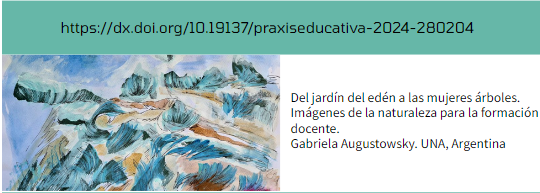From the garden of eden to the tree women. Images of nature for teacher education
DOI:
https://doi.org/10.19137/praxiseducativa-2024-280205Keywords:
teacher education, image didactic, idealized garden, image decolonization, women/natureAbstract
This work deals with images of nature, their possible meanings and uses, within the framework of teacher training. For this, first the images included in the texts of the Moravian theologian and pedagogue Juan Amós Comenio (1592 -1670) and the place of nature - divine creation - as a pedagogical model are analyzed. Then, the work of the Brazilian artist and educator Rosana Paulino (1967) is presented, whose production questions the nature/humanity relationship in the West and calls for subverting the dichotomies of colonialist modernity. The counterpoint between both authors is an invitation to re-look at the images that come to us from tradition and to create, collectively, other/new/more images and imaginaries for education.
Downloads
References
Aguirre Lora, G. M. E. (2019). Un jardín para la infancia. Metáfora comeniana recreada en nuestros tiempos. Historia y Memoria de la Educación, (9), 319-341. https://doi.org/10.5944/hme.9.2019.22668
Augustowsky, G. (2012). El arte en la enseñanza. Paidós.
Augustowsky, G. (2023). La clase imaginada. Variaciones Visuales para pensar la enseñanza. En G. Augustowsky y D. Del Valle (Coord), Territorios de la educación artística en diálogo (pp. 37-52). Universidad Nacional de las Artes.
Berger, J. (2000). Modos de ver. Gustavo Gili.
Camilloni, A. (2016). Leer a Comenio. Su tiempo y su didáctica. Paidós.
Casinelli, D. (2022). Por uma outra imagem do humano: a série jatobá de Rosana Paulino como exercício de descolonização imagética e epistémica. Revista Desvio-IV PEGA, 1(7).
Carneiro, S. (2023). Dispositivo de racialidade. A construção do outro como não ser como fundamento do ser. Zahar.
Comenio, J. A. [1657] (1988). Didáctica Magna. Porrúa.
Comenio, J. A. [1658] (2017). Orbis sensualium pictus. Libros del Zorro Rojo.
Harguindey Barrio, B. (2019). Omnia sponte fluant absit violentia rebus. Neuróptica, (1), 235-237. https://doi.org/10.26754/ojs_neuroptica/neuroptica.201914332
Paulino, R. (2023). Memoria descriptiva de la Serie “Mangue”. Mendes Wood DM. https://mendeswooddm.com/artists/35-rosana-paulino/
Paulino, R. y Carneiro, S. (2023). Antes de estar em mim já esteve nelas. Fundação Bienal de São Paulo.
Runge Peña, A., Piñeres, J. e Hincapié García, A. (2007). Una mirada pedagógica a la relación entre imagen, imaginación y formación humana, tomando como ejemplo el Orbis sensualium pictus de Juan Amós Comenio. Revista Educación y Pedagogía, XIX(47), 1-90.
Santoni Rugiu, A. (1994). Nostalgia del maestro artesano. UNAM.
Smolíková, K. (2020). Imágenes del mundo y el mundo en imágenes. Revista Bibliotecaria Čtenář. https://klarasmolikova.cz/welcome-klara-smolikova-website
Soterio, M. (2022). Tempus. Los emblemas de Alciato y su pervivencia hasta nuestros días. Humanidades: Revista de la Universidad de Montevideo, (11), 193-225. https://doi.org/10.25185/11.8
Ortega, J. M. (2003). Emblemática y didáctica del latín: Un caso práctico. Analecta Malacitana (Anmal electrónica): Revista de Filología de la Facultad de Filosofía y Letras de la Universidad de Málaga, (14). http://www.anmal.uma.es/numero14/emblematica.htm#1ç

Published
Issue
Section
License
Copyright (c) 2024 Gabriela Augustowsky

This work is licensed under a Creative Commons Attribution-NonCommercial-ShareAlike 4.0 International License.
Copyright Notice
Editorial Committee Educational Praxis Magazine:
I hereby declare that I am the author of the article titled (article name), that it is original and my own and that it was not previously published in any other format or medium. I declare to know that the magazine will not charge me any type of fee under any circumstances, nor will I receive any type of monetary compensation If it were accepted for publication in Educational Praxis, I authorize the aforementioned magazine to publish it digitally and to advertise it on its social networks.
If the work is published, I adhere to the Creative Commons license called "Attribution - Non-Commercial Share Alike CC BY-NC-SA", through which it is allowed to copy, reproduce, distribute, publicly communicate the work and generate derivative works, as long as when the original author is cited and acknowledged. This license has been used since September 2018. In 2016 CC BY NC ND 4.0 was adhered to; and in the years 2017 and 2018 (January-August) CC BY NC 4.0.
This CC BY-NC-SA Share Alike license does not, however, permit commercial use of the work. As an author, the journal may establish additional agreements for the non-exclusive distribution of the version of the work published in the journal, it allows me to self-archive the published articles, in their post-print version, in institutional, thematic repositories, personal web pages or any other relevant use. with the recognition of having been first published in this journal.
Educational Praxis adheres to DORA (Declaration on Research Assessment) signed in San Francisco, California, on December 16, 2012, and to the Declaration of Mexico (Joint Declaration LATINDEX - REDALYC - CLACSO - IBICT).














_(1)2.png)


3.png)











_(2).png)






2.jpg)









